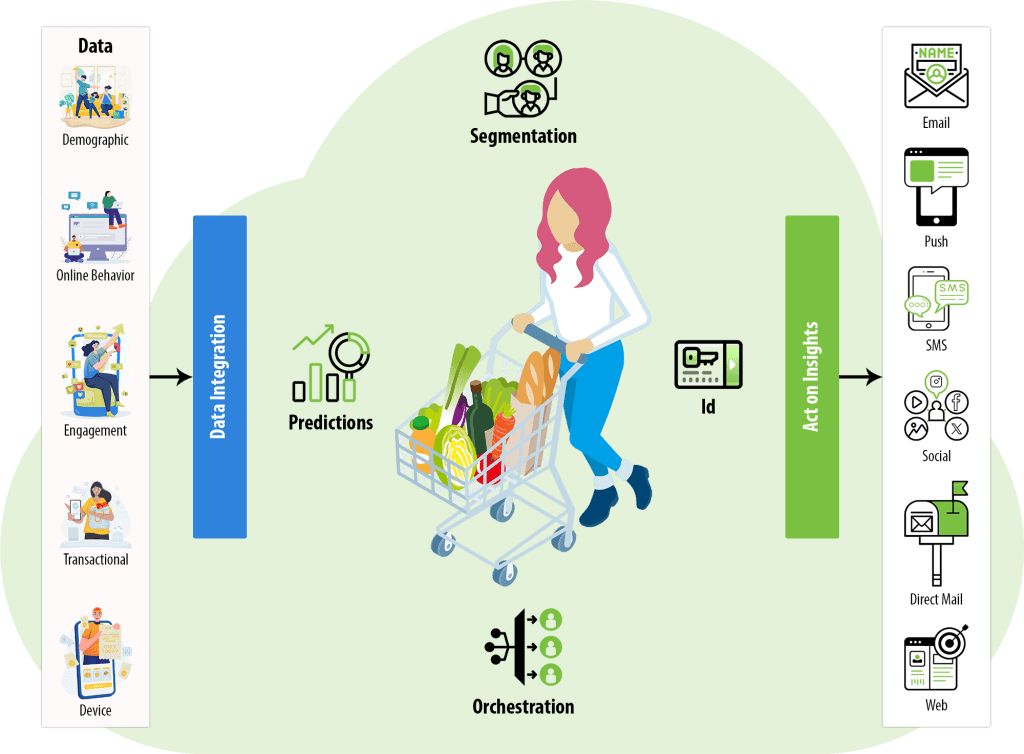In the current digital age, the retail industry has been significantly revolutionized by the advent of innovative technologies that have transformed the customer shopping experience. At the forefront of this transformation is the Customer Data Platform (CDP), a revolutionary tool designed to help businesses collect, manage, and analyze customer data. This in-depth exploration delves into the world of CDPs, highlighting their role in enhancing retail marketing and improving customer experiences.
Understanding Customer Data Platforms
In essence, a Customer Data Platform (CDP) is an advanced software solution that allows businesses to aggregate and unify customer data from various sources into a single, cohesive customer profile. This centralized data hub provides a comprehensive view of the customer, encompassing their behavior, preferences, and interactions with the brand.
For retail marketers, the CDP has emerged as a potent tool, capable of providing in-depth customer insights and facilitating more targeted, personalized marketing strategies. Beyond the marketing sphere, a CDP’s ability to automate certain aspects of customer data management can liberate time and resources, enabling businesses to focus on other crucial areas.

Why Retailers Need a CDP
In the retail sector, customer experience (CX) has become a defining factor influencing customer loyalty and purchasing decisions. As such, retailers are constantly on the lookout for technologies that can help personalize the customer journey. The CDP has emerged as a key player in this arena, offering a wealth of benefits:
Personalization
One of the standout benefits of a CDP in the retail industry is its ability to facilitate personalization. By unifying customer data from multiple sources, retailers can gain a comprehensive understanding of each customer’s behavior, preferences, and needs. This information enables the creation of personalized product recommendations, promotions, and offers for each customer, thus increasing customer engagement and driving sales.
Omnichannel Marketing
A CDP can help retailers deliver a consistent and seamless experience across all channels. With a unified view of customer data, personalization of messaging and promotions can be achieved across all channels, whether it be in-store, online, or on mobile. This approach to omnichannel marketing can improve customer engagement, increase sales, and create a more seamless shopping experience.
Customer Segmentation
CDPs can assist retailers in segmenting customers based on their behavior, preferences, and demographics. This segmentation allows for the creation of targeted campaigns and promotions for specific customer groups, increasing the likelihood of conversion and improving customer engagement.
Inventory Management
CDPs can aid retailers in optimizing inventory levels and predicting demand based on customer behavior and purchase history. This analysis can help identify popular products, predict demand, and optimize inventory levels, thereby reducing the risk of overstocking or stockouts and improving overall inventory management.
The Power of CDPs in Retail Strategy
The potential of CDPs in the retail sector extends beyond the benefits outlined above. They also play a crucial role in business valuation, compliance assurance, relationship-building through personalization and marketing automation, real-time access to customer data and insights, predictive marketing support, and solid return on investment (ROI).
Business Valuation
Investors prefer businesses that strategically utilize their customer data. Retailers that adopt intelligent CDPs can deliver better personalization at scale, improve their return on ad spend, and enhance customer lifetime value and loyalty. The last two are especially important to business valuation. Businesses that improve these numbers demonstrate their expertise in drawing value from their data, thus securing confidence in their performance among board members and investors.
Compliance Assurance
As governments pass more legislation to protect consumer data, CDPs can help businesses stay compliant. Those with multi-tenant cloud architectures are especially useful for global enterprises that want to use the same platform or service across the organization while keeping all their individual data as wholly separate entities. This allows individual teams and business units to have their own accounts within the platform and store, process, and use their data without compromising other teams’ data.
Personalization and Marketing Automation
CDPs can enhance a brand’s online presence by facilitating personalization and marketing automation. Based on consumer data, retailers can develop communications and serve content that’s relevant to a customer’s specific experience and needs. Automation can also support engagement at scale by automating customer journeys based on segmentation, events, or past customer interactions.
Real-Time Access to Customer Data and Insights
The best CDPs feature advanced analytics, easy-to-use dashboards, and machine learning (ML). They offer robust integrations with social media, mobile apps, CRMs, and more. These features produce up-to-date customer data from a single source that teams throughout an organization can depend on.
Predictive Marketing Support
A CDP’s machine learning capabilities give retailers a head start on future sales through predictive analytics that help retailers understand a customer’s likelihood to buy, convert, or engage. Businesses can then allocate their marketing budgets more effectively, fine-tune campaign investments, and adjust supply chains.
Solid ROI
The primary value that CDPs have for retailers is the effect they have on investment returns (ROI). The retailers who use a CDP experience significant growth on a number of fronts, including increased email click-through rates, revenue per email sent, return on ad spend, call center conversion, total omnichannel customers, total loyalty members, customer lifetime value, and business revenue.
Leveraging CDPs for Improved Digital Customer Experiences
The digital customer experience now plays a crucial role in the commercial success of the retail industry. As such, brands need to create and optimize their online and offline digital customer experiences to increase customer satisfaction and loyalty. CDPs offer a means to achieve this, providing end-to-end solutions that unify disparate customer data sources, gain more accurate insights into customers’ needs and preferences, and enable data-driven marketing decisions while protecting customer data.
Better Attribution
One of the key use cases of CDPs in the retail industry involves better attribution. Online retailers often struggle with the sheer volume of data generated by a customer’s journey towards purchase. The data from different channels and devices can make it challenging for marketers to understand which customer engagements were meaningful and led to conversion. That’s where attribution providers can help, but only after a company finds the attribution vendor and methodology at the right level of sophistication. A CDP can alleviate this problem in two ways: streamlining data integration and connecting relevant data from other vendor systems.
CDPs as the Future of Digital Retail
Understanding the value of customer data and implementing a comprehensive CDP is essential for retailers seeking to create a unified customer experience and increase satisfaction. At the same time, businesses need an effective data governance strategy to ensure customers’ personal information is securely managed and not misused, leading to brand loyalty in the long run.
For businesses or marketers looking to learn more, there are comprehensive CDP reports available that can offer further insights into the potential benefits and use cases of CDPs in the retail industry. Embracing this technology can help retailers create more personalized experiences, optimize their operations, and improve customer engagement. By leveraging customer data, retailers can better understand their customers and deliver a more seamless and consistent experience across all channels. The potential of CDPs is vast and can transform the way retailers engage with their customers, improve customer satisfaction, and drive sales.
Implementing a CDP within an organization can provide marketing teams with invaluable insights and improve customer engagement. To get started, it is best to involve key stakeholders in this process early and often. After designing a plan, it’s time to define your goals for using the CDP and what metrics you expect from it over time. While getting started can seem daunting, focusing on these essential steps for the initial setup could put marketing teams on track toward increased customer loyalty and improved marketing results.
In conclusion, the advent of CDPs has significantly revolutionized the retail industry, offering an efficient way to manage and leverage customer data for improved marketing initiatives and customer experiences. As the retail industry continues to evolve and grow, the significance of CDPs is set to increase, making them an indispensable tool for the modern retailer.




















